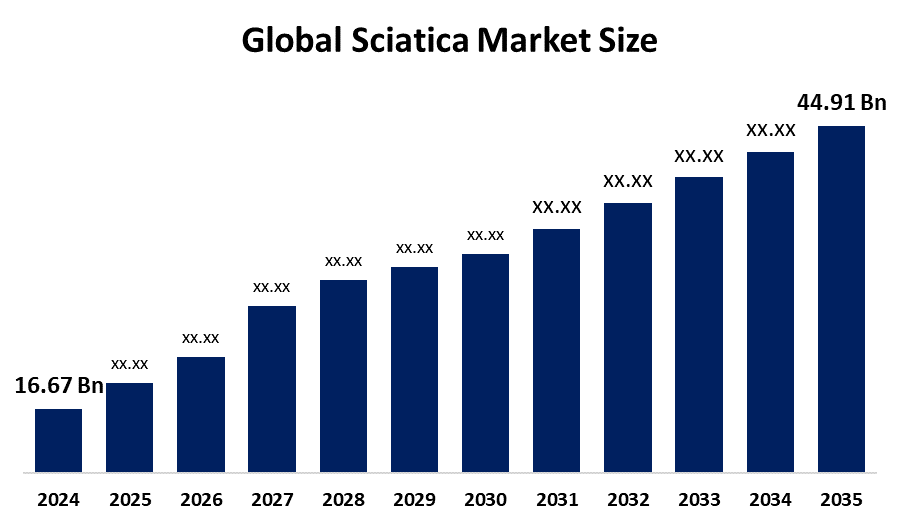- As per Spherical Insights & Consulting, The Global Sciatica Market Size is Expected To Grow from USD 16.67 Billion in 2024 to USD 44.91 Billion by 2035, at a CAGR of 9.43% during the forecast period 2025-2035, owing to the launch of new therapies in the market and the rise in the number of cases.
- The leading Sciatica Market Companies such as GlaxoSmithKline, Medtronic, Pfizer, Sanofi, Abbott Laboratories, Bristol Myers Squibb, Bayer AG, Johnson & Johnson, Boston Scientific, Teva Pharmaceutical Industries, Mylan Pharmaceuticals, Merck & Co., Novartis, Eli Lilly, Stryker Corporation, and Others.

Sciatica Treatment Market: Understanding and Treatment Algorithm:
Sciatica is a condition characterized by pain radiating along the sciatic nerve, typically from the lower back through the hips and legs. It results from nerve compression or irritation, often due to herniated discs, spinal stenosis, or injury, causing symptoms like sharp pain, numbness, and muscle weakness.
Sciatica Diagnosis:
Diagnosis of sciatica involves a physical exam assessing nerve function and pain distribution, combined with patient history. Imaging tests such as MRI or CT scans help identify underlying causes like herniated discs or spinal abnormalities. Electromyography (EMG) may be used to evaluate nerve conduction and muscle response.
Sciatica Treatment:
Treatment for sciatica includes pain management with NSAIDs, muscle relaxants, and corticosteroids. Physical therapy helps improve mobility and reduce nerve pressure. Severe cases may require epidural steroid injections or surgical interventions like discectomy or laminectomy to relieve nerve compression and alleviate symptoms.
Sciatica Epidemiology:
The disease epidemiology covered in the report provides historical as well as forecasted epidemiology segmented by Total Diagnosed Incident Population of Sciatica, Gender specific Diagnosed Incidence of Sciatica, Type specific Diagnosed Incidence of Sciatica, Age specific Diagnosed Incidence of Sciatica, Diagnosed Incident Population based on Primary Site of Sciatica, and Diagnosed Incident Population based on Histologic Classification of Sciatica Tumour in the global market covering North America, Europe, Asia-Pacific, Latin America, the Middle East, and Africa from 2024 to 2035.
Principal Insights:
This section offers a global overview of Sciatica epidemiology in major markets worldwide.
Country Wise Sciatica Multiforme Epidemiology:
- The epidemiology segment provides Sciatica prevalence data and findings across key regions worldwide, including North America, Europe (Germany, France, Italy, Spain, and the United Kingdom), Asia-Pacific (including Japan), Latin America, the Middle East, and Africa.
Sciatica Recent Developments:
- In January 2023, Abbott announced that the FDA approved its Proclaim XR spinal cord stimulation (SCS) system for treating painful diabetic peripheral neuropathy (DPN). This approval offers a non opioid alternative for DPN patients, providing relief through low dose tonic stimulation and remote adjustments via Abbott's NeuroSpher Virtual Clinic app.
Sciatica Marketed Drugs:
• Lyrica: Pfizer
Lyrica (pregabalin) is an anticonvulsant drug commonly prescribed for neuropathic pain, including sciatica. It works by modulating calcium channels to reduce nerve excitability and pain signals. Approved by the FDA for nerve pain, Lyrica helps relieve sciatica symptoms such as shooting pain and numbness.
• Voltaren: Novartis
Voltaren (diclofenac) is a nonsteroidal anti inflammatory drug (NSAID) used to reduce inflammation and pain associated with sciatica. Available in oral and topical forms, it is widely used for managing acute and chronic sciatic pain by inhibiting prostaglandin synthesis.
Sciatica: Emerging Therapies:
- NV 5138: NV 5138 is a novel small molecule in early clinical trials targeting mTORC1 signaling to promote nerve regeneration and reduce neuropathic pain associated with sciatica. By enhancing neuronal repair and modulating pain pathways, NV 5138 aims to provide relief for patients unresponsive to conventional analgesics and muscle relaxants.
- BNT327: It is a bispecific antibody in late-stage trials for sciatica. It targets two immune checkpoints to enhance T cell activation and tumor response, aiming to improve outcomes in patients resistant to standard PD 1 or PD L1 therapies. This approach may offer a novel immunotherapeutic option for sciatica patients with refractory symptoms.
Sciatica Market Outlook:
- The sciatica market involves the diagnosis, treatment, and management of sciatica a condition characterized by pain radiating along the sciatic nerve due to nerve compression or irritation. This market includes pharmaceutical drugs, pain management therapies, and surgical interventions aimed at relieving symptoms and improving patient mobility.
- Key drivers include the rising prevalence of lower back pain and spinal disorders, increasing sedentary lifestyles, and growing awareness of sciatica symptoms. Advances in minimally invasive surgical techniques and expanding geriatric populations further fuel demand for effective sciatica treatments globally.
- Opportunities exist in developing novel analgesics, expanding access to pain management therapies in emerging economies, and integrating digital health solutions for remote monitoring. Increased investment in research on nerve regeneration and personalized treatments also offers significant potential to improve outcomes and market growth.
- Governments are promoting spine health through awareness campaigns, funding pain management programs, and improving access to rehabilitation services. Policies supporting research and subsidizing treatment costs for chronic pain conditions also contribute to better patient care and market expansion.
- High treatment costs and limited access to specialized care restrict patient reach.
- The market is projected to grow steadily due to the increasing prevalence of sciatica and technological advancements in treatment options.
Sciatica Market Segmentation:
By Type:

The L5 nerve root segment holds the largest share in the sciatica market due to its high susceptibility to herniation and compression caused by lumbar disc degeneration. L5-related sciatica often leads to severe pain and functional impairment, driving increased diagnosis and targeted treatment in this segment globally.
By Drug Treatment:
- Anesthetic
- Pain Killer
- Muscle Relaxant
- Antidepressant
- Steroid

Pain Killers dominate the drug treatment segment as they provide immediate relief from sciatica symptoms. Over the counter and prescription analgesics are widely accessible and frequently used to manage acute and chronic sciatic pain, making them the most commonly prescribed medications among patients suffering from sciatica worldwide.
Regional Segment Analysis of the Sciatica Market:
North America holds the largest share in the sciatica market due to its advanced healthcare infrastructure, high awareness about spinal disorders, and widespread access to diagnostic and treatment facilities. The region benefits from well-established reimbursement systems and a high prevalence of lifestyle related back issues. Additionally, the presence of leading pharmaceutical and medical device companies supports ongoing innovation and adoption of effective therapies for sciatica management.
Asia Pacific is the fastest-growing region, driven by increasing healthcare expenditure, growing awareness about musculoskeletal disorders, and expanding access to modern treatments. Rising urbanization and sedentary lifestyles have contributed to a surge in sciatica cases. Additionally, improving healthcare infrastructure, government initiatives, and growing adoption of advanced pain management therapies are accelerating market growth, making Asia Pacific a key area of opportunity for industry players.
Sciatica Market Key Companies:
- GlaxoSmithKline
- Medtronic
- Pfizer
- Sanofi
- Abbott Laboratories
- Bristol Myers Squibb
- Bayer AG
- Johnson & Johnson
- Boston Scientific
- Teva Pharmaceutical Industries
- Mylan Pharmaceuticals
- Merck & Co.
- Novartis
- Eli Lilly
- Stryker Corporation
- Others
Sciatica Therapeutics Market Report Scope:
- The Sciatica therapeutics market report provides a detailed overview, covering its causes, symptoms, disease progression, and existing treatment options.
- Detailed insights into Sciatica’s epidemiology and therapeutic approaches are included.
- Additionally, a comprehensive review of existing and emerging Sciatica therapies is provided, including an evaluation of new treatments expected to influence the current Sciatica treatment market landscape.
- The report includes a detailed review of the Sciatica therapeutics market, both historical and forecasted, highlighting the global drug reach.
- The Patient-Based Sciatica Market Forecasting report offers valuable insights into trends shaping the global Sciatica market, helping to develop effective business strategies.
Sciatica Treatment Market Report Insights:
- Forecasting Market Trends Based on Patient Data and Disease Rates
- Sciatica Therapeutic Approaches in Sciatica
- Review Of Drugs in Development for Sciatica
- Market, Growth, and Trends in Sciatica
- Market Opportunities in Sciatica Treatment
- Effects Of Future Therapies on Sciatica Treatment.
Sciatica Treatment Market Report Key Strengths
- 15 Years Sciatica Market Forecast
- Global Coverage
- Sciatica Epidemiology Segmentation
- Key Cross Competition
Sciatica Treatment Market Report Assessment
- Present Practices in the Sciatica Treatment Market
- Review of Investigational Sciatica Drugs
- Attractiveness of the Sciatica Drug Market
- Sciatica Market Drivers
- Sciatica Market Barriers
- SWOT
- Attribute Analysis
Market Segment:
This study forecasts revenue at the global, regional, and country levels from 2020 to 2035. Spherical Insights has segmented the Sciatica market based on the following segments:
Global Sciatica Market, By Type
Global Sciatica Market, By Drug Treatment
- Anesthetic
- Pain Killer
- Muscle Relaxant
- Antidepressant
- Steroid
Global Sciatica Market, By Regional Analysis
- North America
- Europe
- Germany
- UK
- France
- Italy
- Spain
- Russia
- Rest of Europe
- Asia Pacific
- China
- Japan
- India
- South Korea
- Australia
- Rest of Asia Pacific
- South America
- Brazil
- Argentina
- Rest of South America
- Middle East & Africa
- UAE
- Saudi Arabia
- Qatar
- South Africa
- Rest of the Middle East & Africa






